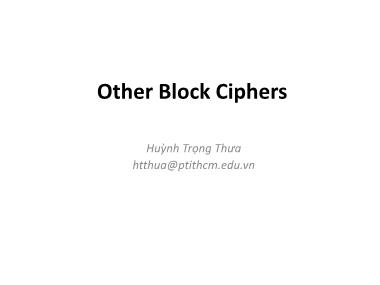Bài giảng Other Block Ciphers - Huỳnh Trọng Thưa
What will we learn?
• The most important modes of operation for
block ciphers in practice
• Security pitfalls when using modes of
operations
• The principles of key whitening
• Why double encryption is not a good idea,
and the meet-in-the-middle attack
• Triple encryption
Encryption with Block Ciphers:
Modes of Operation
• Electronic Code Book mode (ECB),
• Cipher Block Chaining mode (CBC),
• Cipher Feedback mode (CFB),
• Output Feedback mode (OFB),
• Counter mode (CTR).
Bạn đang xem tài liệu "Bài giảng Other Block Ciphers - Huỳnh Trọng Thưa", để tải tài liệu gốc về máy hãy click vào nút Download ở trên
Tóm tắt nội dung tài liệu: Bài giảng Other Block Ciphers - Huỳnh Trọng Thưa

Other Block Ciphers Huỳnh Trọng Thưa htthua@ptithcm.edu.vn What will we learn? • The most important modes of operation for block ciphers in practice • Security pitfalls when using modes of operations • The principles of key whitening • Why double encryption is not a good idea, and the meet-in-the-middle attack • Triple encryption 2 Encryption with Block Ciphers: Modes of Operation • Electronic Code Book mode (ECB), • Cipher Block Chaining mode (CBC), • Cipher Feedback mode (CFB), • Output Feedback mode (OFB), • Counter mode (CTR). 3 Electronic Codebook Mode (ECB) 4 ECB critics • Advantages – Block synchronization is not necessary. • Problem – identical plaintext blocks result in identical ciphertext blocks, as long as the key does not change – Replay attack • Usage: – not recommended to encrypt more than one block of data – encryption in database 5 Ex of Substitution attack against electronic bank transfer • Oscar observes the ciphertexts going through the communication network. • After a while he can recognize the five blocks of his own transfer. He now stores blocks 1, 3 and 4 of these transfers. • The same key is used for several other transfers between bank A and B. • By comparing blocks 1 and 3 of all subsequent messages with the ones he has stored, Oscar recognizes all transfers that are made from some account at bank A to some account at bank B. • He now simply replaces block 4 — which contains the receiving account number — with the block 4 that he stored before. 6 Encryption of bitmaps in ECB mode 7 Cipher Block Chaining Mode (CBC) 8 CBC critics 9 Decryption of all subsequent blocks yi, i ≥ 2 CBC critics (cont.) • Good – Randomized encryption: repeated text gets mapped to different encrypted data. – A ciphertext block depends on all preceding plaintext blocks blocks • reorder affects decryption • Bad – Errors in one block propagate to two blocks – Sequential encryption, cannot use parallel hardware 10 Encryption of bitmaps in CBC mode 11 Output Feedback Mode (OFB) 12 Key stream is not generated bitwise but instead in a blockwise fashion. Cipher Feedback Mode (CFB) 13 Counter Mode (CTR) 14 Exhaustive Key Search Revisited • A brute-force attack can produce false positive results. • Ex: A cipher with a block width of 64 bit and a key size of 80 bit. we find on average 280/264 = 216 keys that perform the mapping ek(x1)= y1. 15 Multiple keys map between one plaintext and one ciphertext Increasing the Security of Block Ciphers • Multiple encryption – Double Encryption – Triple Encryption – Problem: Meet-in-the-Middle Attack • Key whitening 16 Double Encryption and Meet-in- the-Middle Attack • Key length: κ bits • Brute-force attack: require 2κ ·2κ =22κ encryptions (or decryptions) • Meet-in-the-middle attack: – The total complexity is 2κ +2κ = 2·2κ = 2κ+1. 17 Triple Encryption and Meet-in-the- Middle Attack • Key length: κ bits • Brute-force attack: require 2κ ·2κ ·2κ =23κ encryptions (or decryptions) • Meet-in-the-middle attack: – The total complexity is 22κ. – 3DES;:56 bits key => attacker performs 2112 key tests (not 2168) 18 Key Whitening 19
File đính kèm:
 bai_giang_other_block_ciphers_huynh_trong_thua.pdf
bai_giang_other_block_ciphers_huynh_trong_thua.pdf

